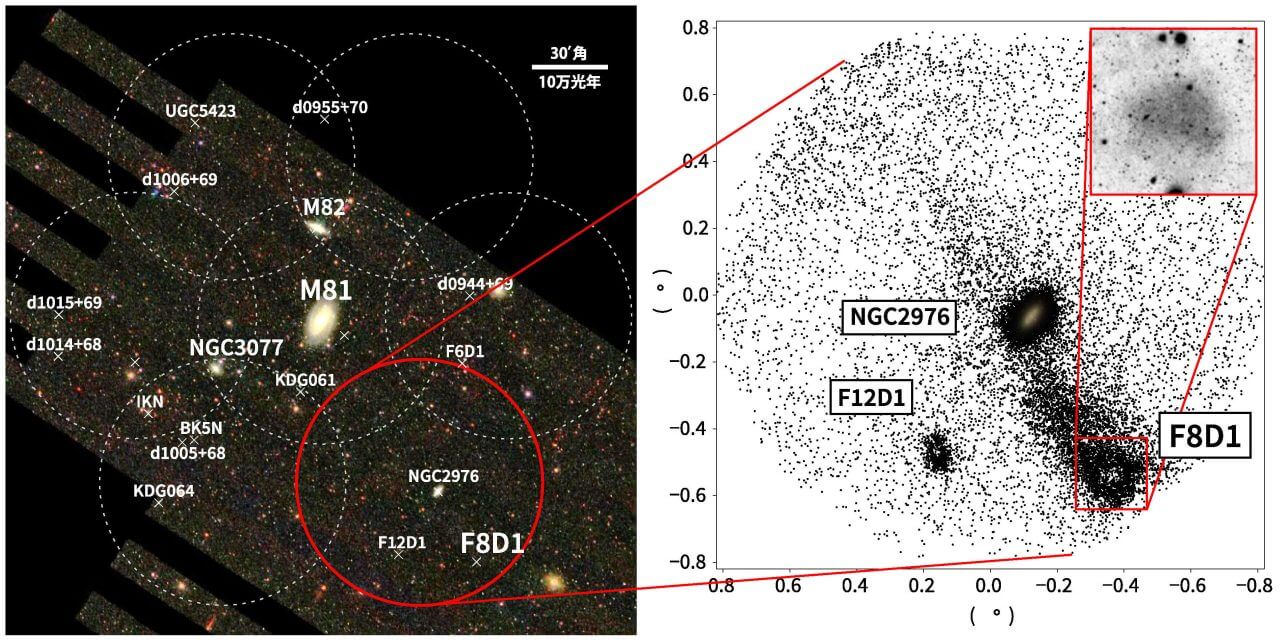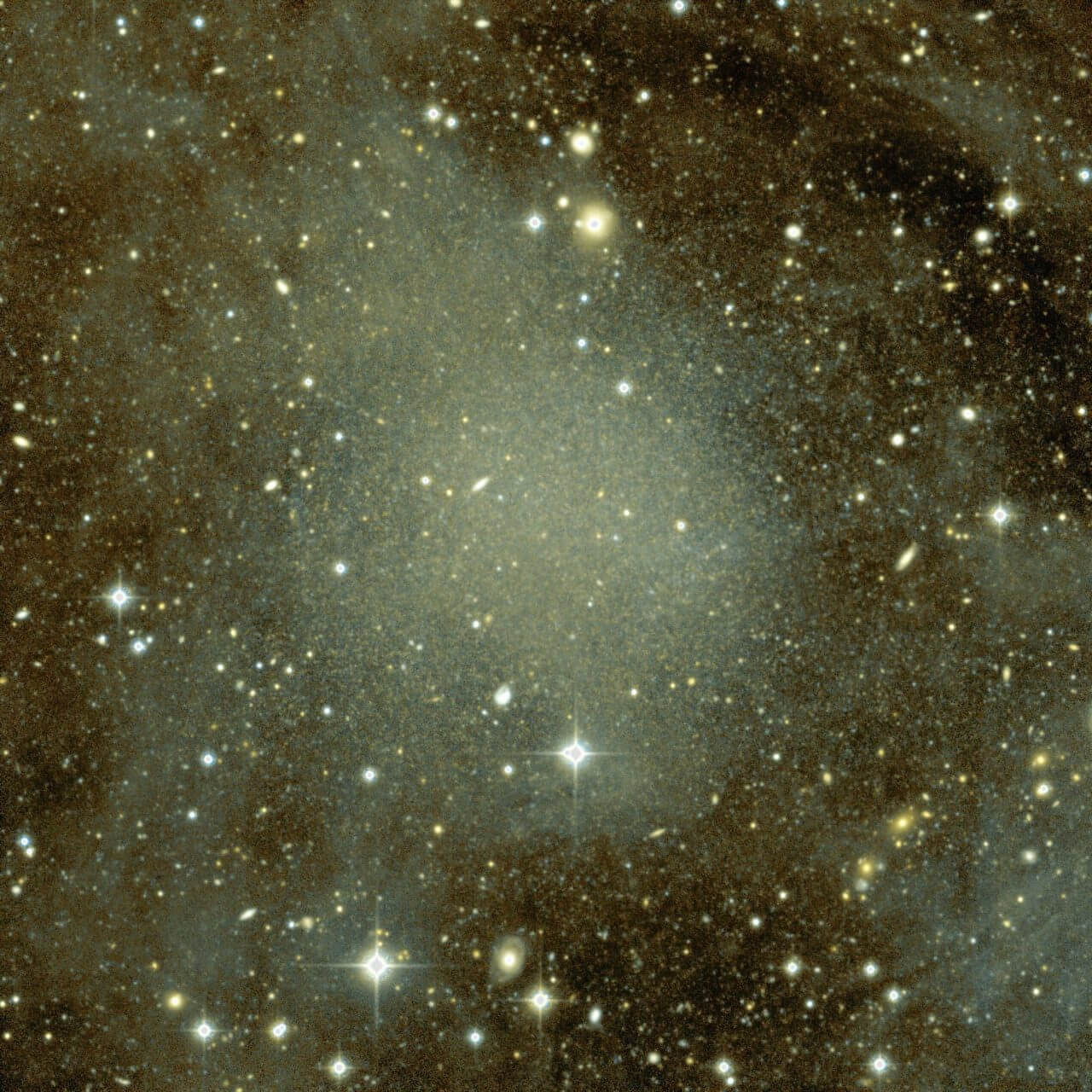[▲ صورة للمجرة فائقة الباهتة F8D1 التي حصلت عليها MegaCam من تلسكوب كندا وفرنسا وهاواي (Credit: CFHT / Cuillandre)]
This ultralight galaxy F8D1 lies about 12 million light-years away in the direction of Ursa Major. It was obtained using the MegaCam Wide Field Visible Light Imager at the Canada-France-Hawaii Telescope (CFHT) on Mauna Kea, Hawaii.
Ultra-diffuse galaxies (UDGs) are very thin and diffuse galaxies, with less than 1/100th the number of stars in the Milky Way. They differ in size and morphology, some have round, smooth shapes similar to dwarf elliptical galaxies (small, dark elliptical galaxies), while others are distorted due to interactions with other galaxies. Close to Earth, F8D1 is a suitable research target to tackle the mystery of ultralight galaxies that contain few stars for their size.
The research team led by Rokas Žemaitis, a doctoral student at the University of Edinburgh, and including the NAOJ researchers, found that results from observations with the NAOJ Hawaii Observatory’s Subaru telescope and CFHT led to the outflow from F8D1. He announced his discovery. A stellar stream (a river-like structure of stars and gas) formed by ancient stars. This is the first time such a structure has been found in a very faint galaxy.

[▲CircleshowingtheareaobservedbytheSubaruTelescope’sHighSpeedFocusCamera(HSC)(leftbackgroundfromtheSloanDigitalSkySurvey)andtheareathatincludesF8D1atthesamedistanceastheM81clustergalaxySchemeillustratingthedistributionofaredgiantstar(right)[▲دائرةتوضحالمنطقةالتيتمتملاحظتهابواسطة”كاميراالتركيزالفائقالسرعة(HSC)فيتلسكوبسوبارو”(علىاليسار،الخلفيةمأخوذةمنمسحSloanالرقميللسماء)،والمنطقةالتيتشتملعلىF8D1علىنفسالمسافةمثلمجرةM81المجموعةمخططيوضحتوزيعنجمأحمرعملاق(يمين)لايمكنرؤيةالتيارالنجميلـF8D1فيصورةHSC،ولكنوجدأنهيمتدفياتجاهM81منخلالتتبعتوزيعالعمالقةالحمراء(Credit:NAOJ)】
F8D1 belongs to the “M81 cluster of galaxies” centered on the spiral galaxy “M81” in Ursa Major, and the stellar stream flows from F8D1 to M81. According to the research team, the stellar stream is about 200,000 light-years across, more than 30 times the size of F8D1, and its length as seen from Earth is more than 1 degree (two diameters for the full moon). This stellar stream is thought to have formed from tidal interactions with M81, and its brightness indicates an outflow of more than a third of the stars that make up F8D1.
The giant stellar stream in F8D1 is an example of how gravitational interactions between galaxies can dramatically change the properties of galaxies, and this finding clearly indicates the possibility of the latter.
“It’s an interesting finding that F8D1 is being destroyed by tides,” said Zemaitis.
Source
- Image credit: CFHT/Cuillandre, National Astronomical Observatory
- National Astronomical Observatory Subaru Telescope – Discover a long stream of stars from a very faint galaxy
- CFHT – A Tale of a Tail: A Tidally-Disrupted Diffuse Ultra Galaxy Galaxy in the M81 Group
- Chimaitis and others – A tail’s tale: a progressively disrupted super-diffuse galaxy in the M81 cluster (Monthly Notifications of the Royal Astronomical Society)
Sentence editing section

“Travel maven. Beer expert. Subtly charming alcohol fan. Internet junkie. Avid bacon scholar.”







More Stories
April 2024 update released for OPPO Reno9 A – OPPO Lab
[الحل]An error occurred and the iPhone could not be restored. AnyFix 2.2.4.0 announced | iMobie press release
Nintendo's Wii has shrunk to the size of a playing card! How did you modify it? |.GetNavi Web GetNavi